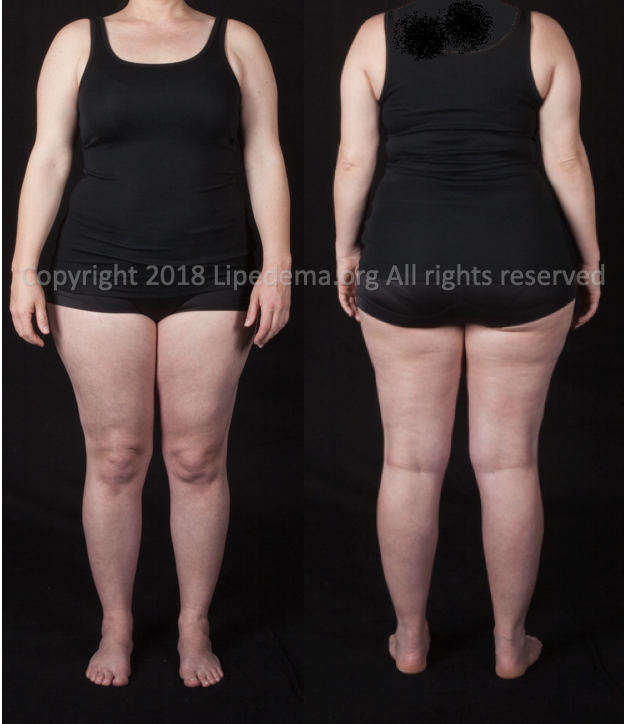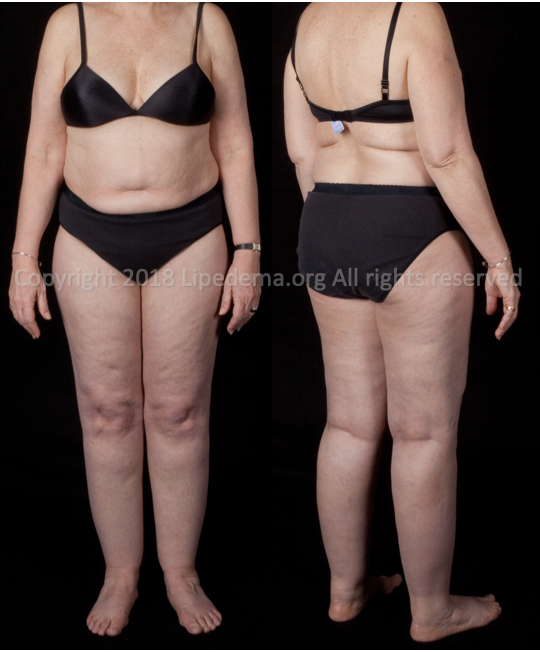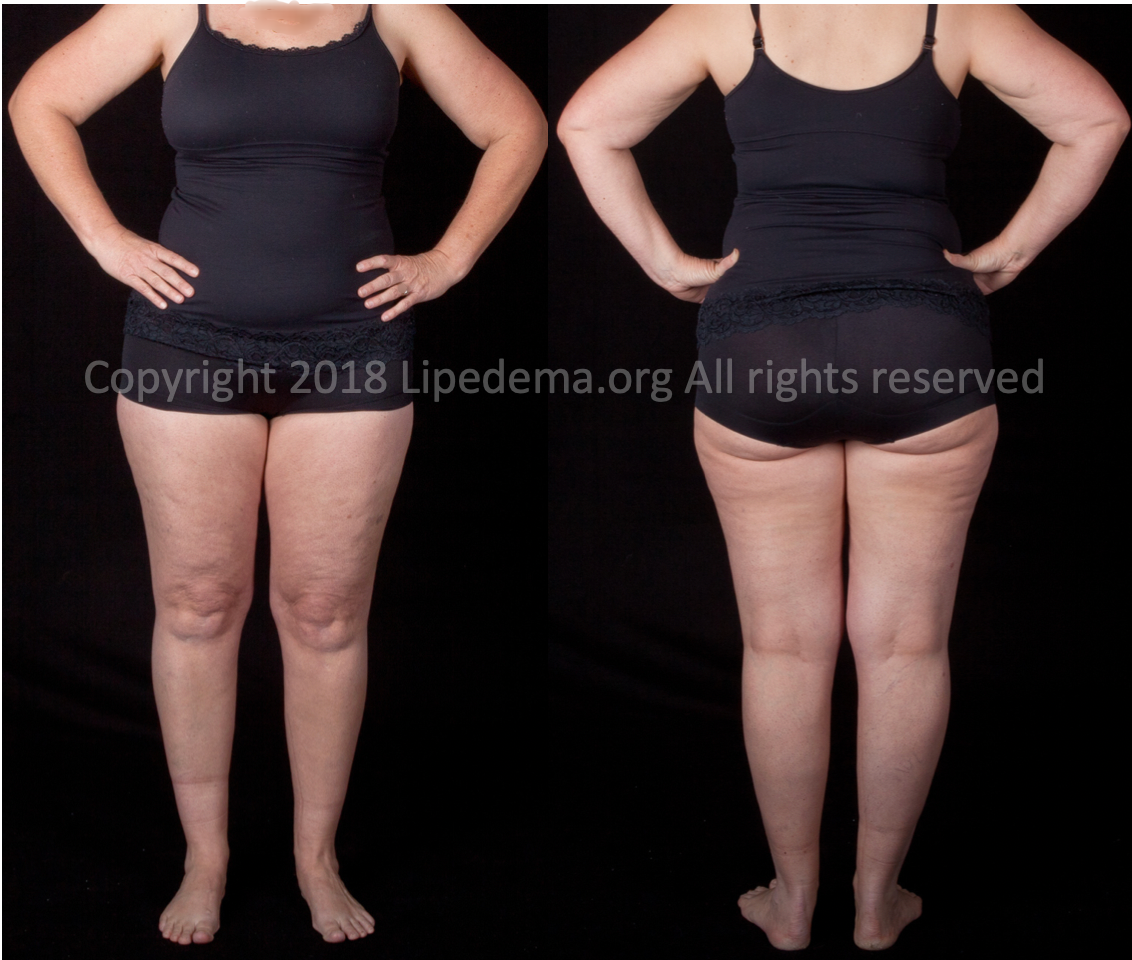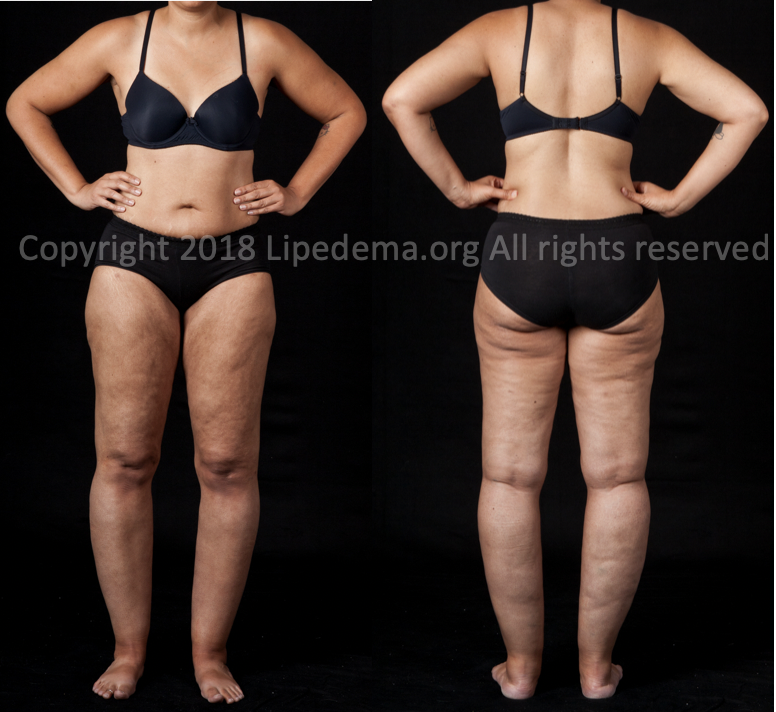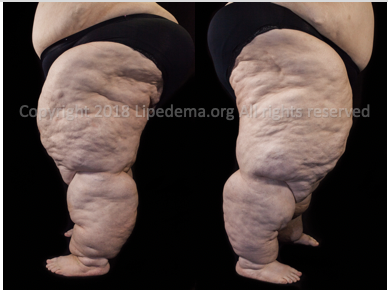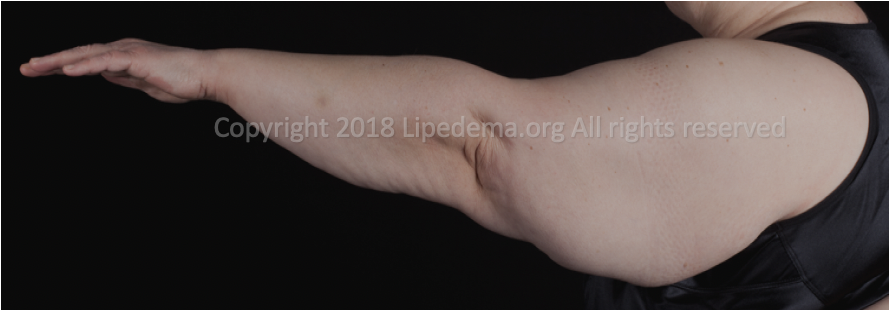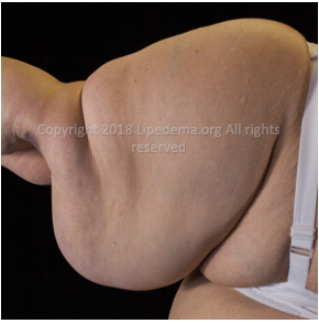Staging of Lipedema
Page updated July 2025
Lipedema is typically categorized into three stages: Stage 1, Stage 2, and Stage 3. These stages are based primarily on morphological characteristics, which include changes in skin texture, nodularity, fibrosis, and abnormal fat deposits. Most authoritative sources currently assess a patient’s Lipedema stage by examining the legs / lower extremities. Although some clinicians have historically attempted to assign stages to other areas, such as the arms, the prevailing standard today is to determine staging based exclusively on the lower limbs.
The staging definitions and selection of example images below were informed by a structured analysis of published staging criteria. We examined peer-reviewed articles and clinical guidelines, comparing descriptive language and diagnostic criteria to extract overlapping elements and construct a staging framework. The images below provide an overview of the three stages of Lipedema, showing the location of fat buildup and resulting body shape at each stage. Depending on the person, different parts of the body can be affected in different ways at each stage.
These staging criteria, although often used, do not take into consideration that pain, size, impact on joints, tenderness, loss of mobility, or other impacts to quality of life often worsen with higher stages. Other criteria are sometimes used. LF would like to fund research that determines a better way to stage patients with Lipedema.
These images are protected by copyright laws and the reproduction or distribution of any of these photos is strictly prohibited.
Note: You will also see below depictions of lipolymphedema, which is when both Lipedema and lymphedema (tissue swelling caused by an accumulation of lymph, protein-rich fluid that's usually drained through the body's lymphatic system) are present. Previously, some sources referred to lipolymphedema as “Stage 4” Lipedema. However, the concept of Stage 4 has been challenged, with some in the medical community arguing that the lymphatic system can be compromised by Lipedema at any stage. The Lipedema Foundation no longer uses the “Stage 4” designation.
STAGE 1
Smooth skin with an increase of enlarged subcutaneous fat tissue.
Fat is often soft, though sometimes small nodules may be felt under the surface of the skin (sometimes described as ("rice-like", “pebble-like”, "pearl-sized", or "Styrofoam balls in a plastic bag").
Fat buildup around pelvis, buttocks, and hips. For more images go here.
Fat buildup from buttocks to knees, with folds of fat around the inner side of the knee. For more images go here.
Fat buildup from buttocks to ankles. For more images go here.
stage 2
Uneven skin surface – indentations, dimpling, and/or a “wavy” “orange peel” (‘peau d’orange’), or “mattress-like” look.
Large nodules, walnut to apple size, may be felt under the surface of the skin.
Fat may be thickened, hardened, fibrotic.
Fat buildup around pelvis, buttocks, and hips. For more images go here.
Fat buildup from buttocks to knees, with folds of fat around the inner side of the knee. For more images go here.
Fat buildup from buttocks to ankles. For more images go here.
stage 3
Large extrusion of fat tissue, lobules, or overhangs of fat causing deformations, especially on the thighs and around the knees.
Nodularity and thickening of the adipose/fibrosis is very common. Large nodules, walnut to apple size, are often numerous.
Large extrusions of fat tissue causing buildup from buttocks to knees, with folds of fat (lobules) around the inner side of the knee and at the thighs. For more images go here.
Large extrusions of fat tissue causing buildup from buttocks to ankles. For more images go here.
Lipolymphedema (sometimes previously referred to as Stage 4)
Development of lipolymphedema, which is when both Lipedema and lymphedema (tissue swelling caused by an accumulation of lymph, protein-rich fluid that's usually drained through the body's lymphatic system) are present.
It is important to note that lymphedema can be present at all stages.
You can find more information about lymphedema here.
Large extrusion of fat tissue on legs with comorbid lymphedema. For more images go here.
Large extrusion of fat tissue on legs with comorbid lymphedema. For more images go here.
staging of lipedema in arms
Nearly 80 percent of women with Lipedema also present with fat on their upper limbs (8). The affected tissue can be located on their upper arms, lower arms, or throughout the entire arm.
stage 1
Fat buildup in upper arms (front view). For more images go here.
Fat buildup in lower arms (rear view). For more images go here.
stage 2
Fat buildup in upper arms (front view). For more images go here.
Fat buildup in the lower arms (side view). For more images go here.
stage 3
Fat buildup in upper arms (side view). For more images go here.
Fat buildup in upper arms (rear view). For more images go here.
Lipolymphedema (sometimes previously referred to as Stage 4)
As in the legs, lipolymphedema can develop in the arms. Lipolymphedema is when both Lipedema and lymphedema (tissue swelling caused by an accumulation of lymph, protein-rich fluid that's usually drained through the body's lymphatic system) are present.
It is important to note that lymphedema can be present at all stages.
You can find more information about lymphedema here.
Fat buildup in entire arm (rear view). For more images go here.
Fat buildup in entire arm (front view). For more images go here.
Fat buildup in entire arm (side view). For more images go here.
More information on staging can be found in Lipedema: A Current Understanding of its Pathology and Natural History (see pages 20-22).
References
Lipedema Foundation. Lipedema: A Current Understanding of Its Pathology and Natural History.; 2023. https://www.lipedema.org/roadmap
Kruppa P, Gohlke S, Łapiński K, et al. Lipedema stage affects adipocyte hypertrophy, subcutaneous adipose tissue inflammation and interstitial fibrosis. Frontiers in Immunology. 2023;14. Accessed July 28, 2023. https://www.frontiersin.org/articles/10.3389/fimmu.2023.1223264
Bertsch T, Erbacher G. JWC International Consensus Document: Lipoedema: a paradigm shift. Journal of Wound Care. 2020;29(11). doi:https://doi.org/10.12968/jowc.2020.29.Sup11b.1
Fife CE, Maus EA, Carter MJ. Lipedema: a frequently misdiagnosed and misunderstood fatty deposition syndrome. Adv Skin Wound Care. 2010;23(2):81-92; quiz 93-94. doi:10.1097/01.ASW.0000363503.92360.91
German Society for Phelobology and Lymphology, ed. Lipedema guideline: S2 Guideline of the German Society for Phlebology and Lymphology. Accessed February 20, 2024. https://register.awmf.org/de/leitlinien/detail/037-012
Herbst KL. Rare adipose disorders (RADs) masquerading as obesity. Acta Pharmacol Sin. 2012;33(2):155-172. doi:10.1038/aps.2011.153
Herbst KL, Kahn LA, Iker E, et al. Standard of care for lipedema in the United States. Phlebology. Published online May 28, 2021:02683555211015887. doi:https://journals.sagepub.com/doi/10.1177/02683555211015887
Herbst KL, Mirkovskaya L, Bharhagava A, Chava Y, Te CHT. Lipedema Fat and Signs and Symptoms of Illness, Increase with Advancing Stage. ARCHIVES OF MEDICINE. 2015;7(4):8.
Keith L, Seo C, Wahi MM, et al. Proposed Framework for Research Case Definitions of Lipedema. Lymphat Res Biol. Published online March 28, 2024. doi:10.1089/lrb.2023.0062
Reich-Schupke S, Schmeller W, Brauer WJ, et al. S1 guidelines: Lipedema. J Dtsch Dermatol Ges. 2017;15(7):758-767. doi:10.1111/ddg.13036
Schmeller W, Meier-Vollrath I. Lipödem: Moderne Diagnostik und Therapie. Gefässchirurgie. 2009;14(6):516-522. doi:10.1007/s00772-009-0747-4
Schmeller, Wilfried, Meier-Vollrath I. Lipedema (Chapter 7). In: Weissleder H, Schuchhardt C, Baumeister RGH, eds. Lymphedema : Diagnosis and Therapy. 4th ed. ViaVital Verlag, GmbH; 2008:294-323.
Strößenreuther R, Baumeister RGH. Lipödem und Cellulitis: sowie andere Erkrankungen des Fettgewebes. Viavital-Verl; 2001.
Wounds UK. Best Practice Guidelines: The Management of Lipoedema. Wounds UK; 2017. Accessed October 21, 2020. https://www.lipoedema.co.uk/wp-content/uploads/2017/05/WUK_Lipoedema-BPS_Web.pdf

